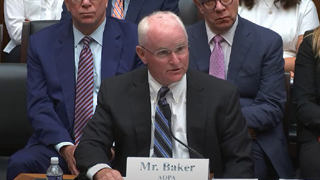
An ‘important fabric of our nation’
Baker briefs Congress on the state of GA
AOPA President Mark Baker was among several general aviation leaders who informed Congress on the current state of the industry during a House Transportation and Infrastructure Committee hearing in July. Baker highlighted several issues including GA’s improved safety record, aviation workforce challenges, airport hangar shortages, and the most pressing issue facing GA today: the need for a safe and smart transition to unleaded fuels for piston aircraft. In his testimony, Baker called GA an important fabric of our nation—a $247 billion industry supporting more than 1.2 million jobs and serving communities with more than 5,000 public-use airports across the country.
Baker outlined how GA weathered the storm in the aftermath of the COVID-19 pandemic, with an increasing number of aircraft taking to the skies without a compromise to safety. In fiscal year 2021, GA had the safest year ever with a fatal accident rate of 0.74 accidents per 100,000 flight hours. That followed a decades-long trend of historically low accident rates, which have declined by about 50 percent over the past 25 years.
The hearing generated discussion on aviation workforce challenges—especially as travel woes such as weather, air traffic control delays, and staffing issues have come to the forefront in the news media. According to Boeing Co., numbers suggest a need for 612,000 new pilots, 626,000 new maintenance technicians, and 886,000 new cabin crewmembers over the next 20 years. Baker and the GA leaders also fielded questions from the committee on topics including costs of flight training, diversifying the aviation workforce, designated pilot examiner shortages, and unleaded fuel.
aopa.org/pilot/congress
Action in the states
California. Perched on the steps of California’s state capitol, the brightly painted Cirrus put a positive spotlight on general aviation for California’s Aerospace and Aviation Day. Hosted by the Association of California Airports, the two-day event in Sacramento was designed to educate legislators, staff, and the public about the importance of aviation to the state. Along with the California Pilots Association, the National Business Aviation Association, and other industry stakeholders, AOPA played an active role as sponsor in highlighting issues such as airport preservation, aviation funding and infrastructure, renewable energy policies in airport planning, the coming generation of electric aircraft, and safely transitioning to unleaded aviation fuel.
New Jersey. AOPA submitted testimony in favor of a New Jersey bill that would give small general aviation airports the flexibility to roll over state grants into the next fiscal year. AOPA testified that the bill would benefit smaller airports and keep them competitive with larger ones in the state. “This modification will bring much needed stability for the smaller public-use airports that tend to lack staff to efficiently process the multitude of tasks required for each eligible project. As such, passage of A4092 will assuage fears about losing grants at airports unable to process them with the same expedience as larger airports,” AOPA said.
aopa.org/advocacy/state-advocacy
Making a good airport great!
By Mike Ginter, AOPA vice president, airports and state advocacy
Since my column on airport culture in the August issue, I received a few comments from members asking for examples of airports with good “vertical alignment.” Vertical alignment exists when elected leaders, airport management, and pilots understand the value of their airport and work collaboratively. When this alignment exists, good airports can become great airports.
Culpeper Regional Airport (CJR) in Virginia enjoys exceptional vertical alignment and the resulting success. The former and current county executive actively support the airport and foster innovative growth strategies. The county board of supervisors also supports the airport. The airport advisory committee includes pilots and community business leaders, and it is relied upon to make recommendations on airport matters. The airport manager is trained, competent, and fully supported by her leadership. And the pilot community is generally happy and knows that Culpeper is a “pilot’s airport.”
Vertical alignment enabled many pro-growth vectors to be realized. In 2007, voters removed the county’s aircraft property tax, which disincentivized new aircraft ownership. County leaders and local pilots developed a proposal to invite new aviation businesses. And in 2014, the airport completed three rows of new T-hangars funded by an innovative hybrid funding scheme, which added new revenue streams to support future projects. In addition, the annual Culpeper Air Fest enjoys strong community support. These growth vectors started two decades ago with an innovative vision of what the airport could become.
Many airports, like Columbus Municipal Airport (BAK) in Indiana and Springfield-Beckley Municipal Airport (SGH) in Ohio, enjoy this vertical alignment. When such an innovative and cohesive vision is implemented, a good airport becomes great. [email protected]
On the front lines
Will your crosswind runway be here tomorrow?
By Adam Williams, Manager, airport policy
Whether you are a student pilot or experienced aviator chasing proficiency or an advanced rating, you know that access to a crosswind runway is nice to have for training, and essential when the crosswind component approaches or exceeds the aircraft’s capabilities. This is especially true for aircraft with a little wheel under the tail.
AOPA has worked with members at many airports over the past few years where funding for rehabilitation of the crosswind runway is threatened. The FAA will consider funding crosswind runway projects when the average prevailing wind does not support using the primary runway 95 percent of the time.
We estimate more than 1,000 public airports currently have a crosswind runway in addition to the main runway. We’re certain that some of them, perhaps 10 percent or more, will have that runway’s funding eligibility challenged the next time the airport seeks an FAA or state grant to maintain it. Since airports rely on these grants, which pay 90 percent or more of the project cost, grant eligibility can determine if a crosswind runway will remain.
If your crosswind runway is being threatened because of loss of FAA funding, inform your Airport Support Network volunteer or call AOPA at 800-USA-AOPA.


